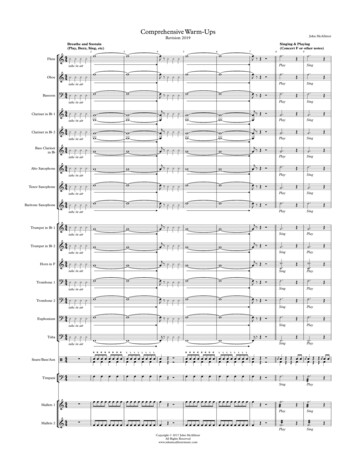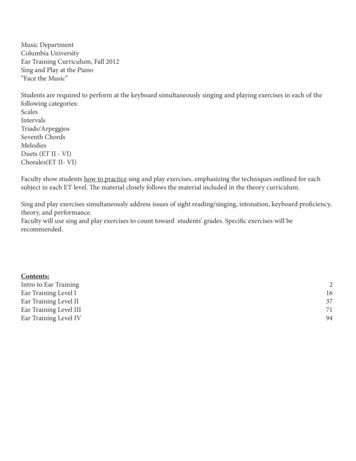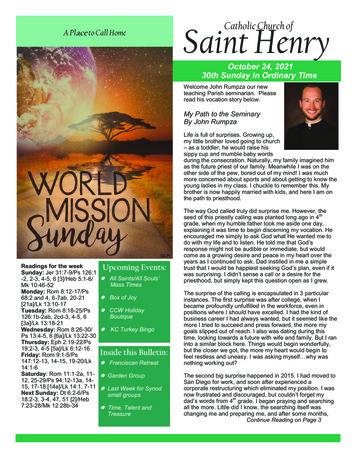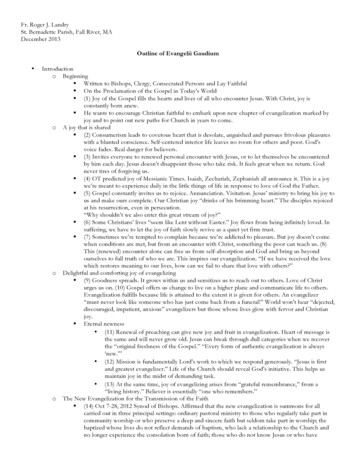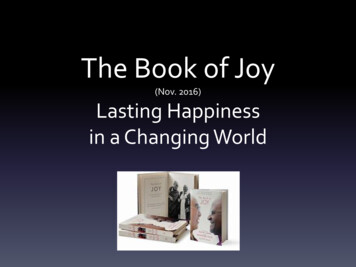
Transcription
SING FOR JOYAND LEARNINGPractice note for earlylearning and childcareservices
Singing, music and dance‘By regular, rhythmic movements – and this is of specialimportance – the parent/carer/practitioner brings this life withinthe child’s conscious control when they dandle them up and downon their hand or arm in rhythmic movements and to rhythmicsounds’. (Froebel 1898:70)Many opportunities for young children to engage incommunication and play, have been impacted by the‘If you cannotCovid-19 pandemic. High quality early learning andteach me tochildcare (ELC) can be a major driver towards influencingfly, teach meearly language skills development, as can language usedto sing.’in the child’s home and in social activities, such asmeeting with friends. During the pandemic childrenJ.M. Barriehave spent significantly less time in their ELC settingsand less time with friends and family than theynormally would have. To support children in their developmentas we move forward, singing, music and dance should be a regularactivity in a setting.We know there are many benefits for children from singing naturally in their playand learning experiences.The Scottish Government advisory subgroup on education recognise the importance of singing forchildren’s health and wellbeing as well as for their social, physical and cognitive development.Further information is available on the Scottish Government website.The purpose of this practice note is to promote creative singing experiences. Providers and staffshould make decisions based on risk assessment, scientific advice, the latest guidance and the needsof individual children.
Benefits of children singing“These all form an important part ofthe journey towards literacy,coordinating sight, sound and movementand contributing towards future readingand writing.” (Bruce and Spratt 2011)Aids brain development Children singing causes the brain to perform multiple tasks at once. This helps to develop memory.From remembering lyrics to remembering a cue to start singing, the brain learns to handle moretasks that is required to perform simultaneously. Children singing encourages deep breathing, getting more oxygen to the brain. Children singing teaches opposites, from fast and slow to loud and quiet. A child will learn todifferentiate between opposite tasks. Children singing gets the endorphins flowing in the brain. This causes the body to feel good andincreases brain activity. It helps a child learn to concentrate on a task. One of our favourite benefits of children singing is that it can help to develop a child’s imaginationand creativity.Aids language development Self-expression.Vocal imitation.Self-confidence and helps aid a child to communicate with others.Helps to strengthen the lips and tongue and aids muscle memory.Helps a child speak more clearly and develops variety of vocabulary.Children develop rhythm and learn how to rhyme words.Children learn the importance of listening in order to learn their favourite songs. They learn howto enjoy listening to things and how to think about things while they listen. Being part of a group can give children a feeling of belonging and can help them make friends.Children develop their language and communication skills through play and interactions through dailyactivities. Supporting early language development is a key factor in promoting children’s readiness tolearn to read. In recognition of this, Save the Children published ‘Ready to Read’ (2015) as part of the‘Read On. Get On.’ campaign. This practice note looks at boosting children’s early language skills andnarrowing the attainment gap to improve life chances for all of Scotland’s children.Our ‘Getting ready to read’ resource identifies that singing promotes early language developmentand looks at the foundations of supporting children to learn to read. This practice note can be usedto identify singing experiences and resources to promote early language development in indoor andoutdoor environments.
Use the following suggestions to encourage children in yoursetting.Suggested experiencesSinging - 0-3 yearsBackground music, songs or sounds (allowing for quiet periods at points across the day).Song washing lines, song bags, baskets, tree (for instance, peg up photographs, images or otherobjects that prompt children to think of songs they already know or songs they can make up).Active songs inside and outside. These could be enhanced with materials such as play-dough or sandso they can carry out physical activity alongside singing.Interactive songbooks or props.Virtual singing resources in partnership with significant others such as parents, grandparent,keyworker or siblings.Makaton singing session.Video children singing and play back for repetition, enjoyment and understanding.Singing - 3-5 yearsInteractive whiteboard singing, dance or movement sessions.Pre-recorded songs from key staff members to share with families at home.Virtual singing sessions with other settings including intergenerational.Song baskets, bags or tubs with props for singing.Laminated song cards or velcro song board.Wooden spoon song props (decorate spoons as characters from songs).Song books, sheets or cards.Stories that include song, for instance ‘There was an old lady who swallowed a fly’.
Singing 5- 12 yearsResources to support creativity in older children.Microphone, dance floor, video technology, song sheets or karaoke machine.Create a choir.Produce a music video.Plan a talent show session.Write lyrics to songs and perform.Encourage the children to teach you songs they like.Missing lyrics competition.Name that tune. Play an introduction to a song or just a few notes to encourage children toguess the song.Rhyme 0-3 yearsEgg shakers, rain makers, keyboard, selection of drums, wrist or foot bells, maracas, xylophone,tambourine, drumsticks.Interactive rhyme books, taking turns or sharing for social development.Wooden spoon and loose parts materials for exploring rhyme, beat, words and sounds.Malleable materials to follow rhyme beat, rhythm, and support expression of emotion.Marching, stamping and clapping out rhyme and beat.Guess the rhyme game (for instance, props in a bag).Rhyme 3-5 yearsMake own fun rhyme or act outFinger puppets, hand puppets, wooden puppets to spark children’s imaginations.Magic bag rhymes with variety of props for choice or child led.Clap, stamp, jump, roll out rhymes for active participation and fun.Rhyme box, tent or tree (photographs, images or other objects that prompt children to think abouthaving fun with rhymes).
Rhyme 5-12 yearsMake own rap song and perform to an audience.Competition to make a rhyme about an object.Make rhymes about interests, friends or animals.Dance 0-3 yearsBackground music.Video links.Dance 3-5 yearsCreate a dance stage or platform.Use materials for free flow dancing, scarves, silk ribbons or shakers.Shadow dancing outdoors.Dance 5-12 yearsDance competition – different genres.Dance fads through the years.Learn a new routine.Music 0-3 yearsEgg shakers, rain makers, keyboard, selection of drums, wrist or foot bells, maracas, xylophone,tambourine, drumsticks, scarfs, ribbons, bean bags.Feel the music – vibrations form different objects.What is that sound game?Music from around the world. You could have related props.
Music 3-5 yearsMusic sound lotto.Range of musical instruments displayed attractively.Music stage, curtains, lighting.Encourage children to experience traditional music from different cultures and styles and differenttime periods.Music 5-12 yearsProvide the resources for children to plan and organise a Karaoke party.Develop a musical theatre.Encourage children to set up a dance school or class.Ballroom dancing set, costumes, makeup artists, music.Make loose parts musical instruments.Investigate musical instruments and cultures of the world.Research the history of music for instance, rock and roll, blues, pop, heavy metal, hip-hop, dance.
More practice suggestions to share Copying funny faces to different types of music. Fun breathing games to different types of music with the adult talking children through it ratherthan doing it. Relaxation to music and breathing deeply. Outdoor singing opportunities. Parachute games. What is that sound? Talking rhymes. Clapping rhythm games. Following the leader to music. Makaton to spoken rhymes. Music on a digital source – CD player / Smartboard /tablet Recording of adults singing or videos of adults singing. Musical instruments – following the rhythm games. Storybooks which encourage movement, such as ‘The enormous turnip’ Outdoor singing in groups, on walks. For example, ‘We are going on a bear hunt’ and other actionsongs that children can act out, the Gruffalo song. Musical tales. Musical storytelling where they say the story or song and act it out, for instance, the wheels onthe bus, Santa got stuck up the chimney. Makaton rhymes and learning new signs. Sound stories with facial expressions, animal sounds. Peek a boo. Finger puppets and puppets. Dressing up. Making up stories to different music – using imagination. Musical statues, musical bumps, dancing to music, instruments and sounds using a variety ofmusic, from pop to classical, for children to dance to. Dancing with props hats, balloons, wigs, teddy bears. Mood music, a collection of songs depicting different emotions – anger, happiness, sadness, andfun. Dance like an animal or be the animal in a story. Expression, dancing to music using scarves, voile, paper wands, streamers, ribbons.
Mindfulness / mediation. Positive affirmations. Make your own musical instruments, for instance, drums crafted out of old containers, guitarcrafted out of an old shoebox. Provide opportunties for children to express music through their creativity. For instance, set musicnext to an easel, and observe how this is expressed in paint.The Environment‘Adults admire their environment, they canremember it and think about it; but the childabsorbs it’ (Montessori, The Absorbent Mind, 1949:63).Q1 2.1 Quality of the setting for play and learning: children benefit from high quality, care play and learning settings staff enable children to influence the design of the setting and the provision of appropriateresources and how they use them.(Draft quality framework for daycare of children, childminders and out of school care)An environment with access to a good range of appropriate resources is important for stimulatingearly speech, language and communication.Things to think about: How does the service ensure that the environment, both indoors and outdoors, promotes earlylanguage, speech and communication for children in the setting? Where can staff sit comfortably with children? What height are resources displayed at? How do resources stimulate creativity? How do noise levels and the atmosphere impact on children’s experiences? How well does your environment celebrate cultural and language diversity?Health and Social Care Standard 5.21: I am able to access a range of good quality equipment andfurnishings to meet my needs, wishes and choices .
://www.careinspectorate.com/images/ELC practice scot/?page id media/3bjpr3wa/realisingtheambition.pdfBruce, T. and Spratt, J. (2011) Essentials of Literacy from 0-7, 2nd ed. London: SageFroebel, F. (1898, first published 1826) The Education of Man. New York, London: Appleton
HeadquartersCare InspectorateCompass House11 Riverside DriveDundeeDD1 4NYTel: 01382 207100Fax: 01382 207289Website: www.careinspectorate.comThis publication is available in alternative formats on request. Care Inspectorate 2022 I Published by: Communications I COMMS-0721-347@careinspect www.freepik.comcareinspectorate
SING FOR JOY AND LEARNING Practice note for early learning and childcare services. Singing, music and dance . have spent significantly less time in their ELC settings and less time with friends and family than they normally would have. To support children in their development as we move
